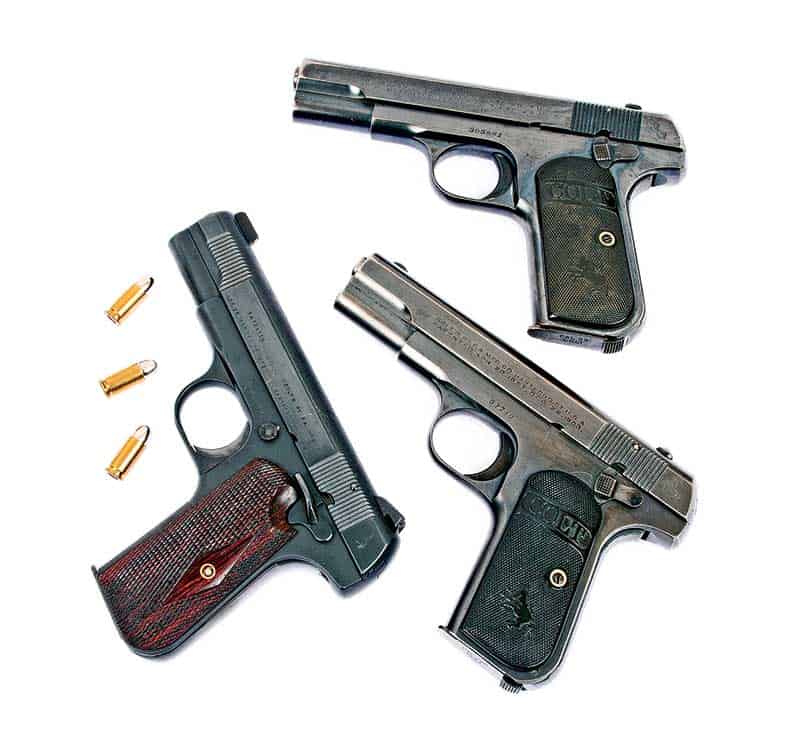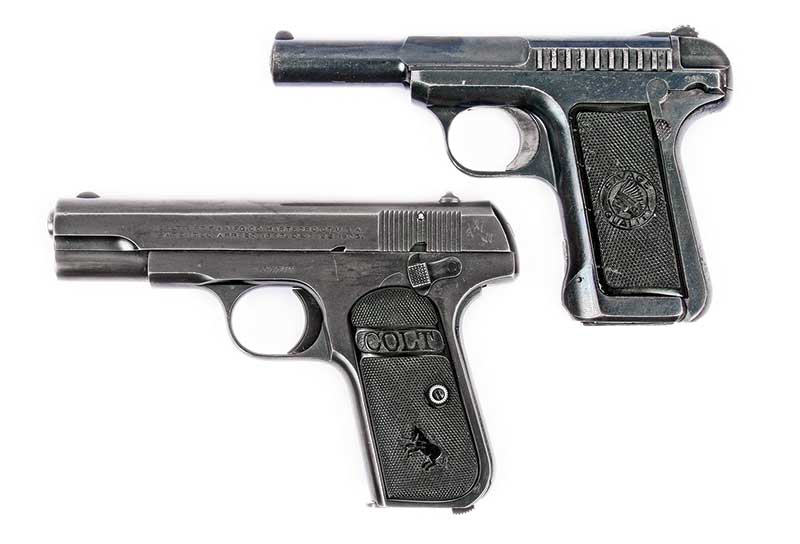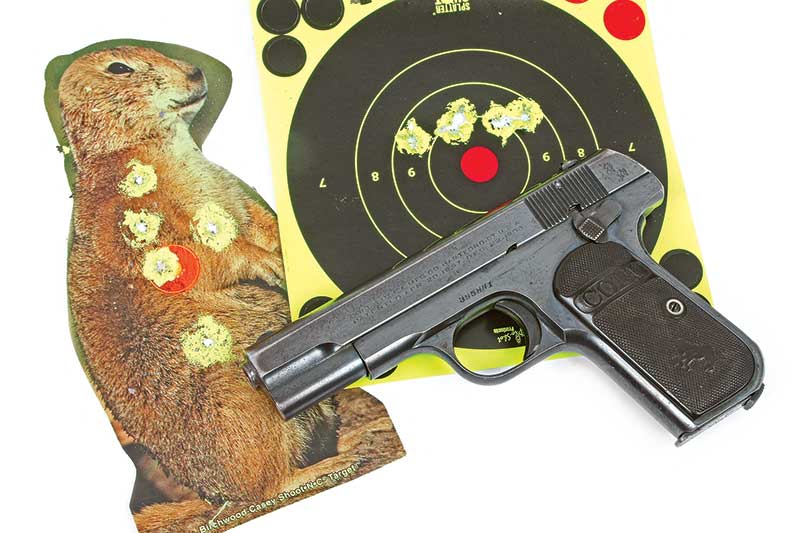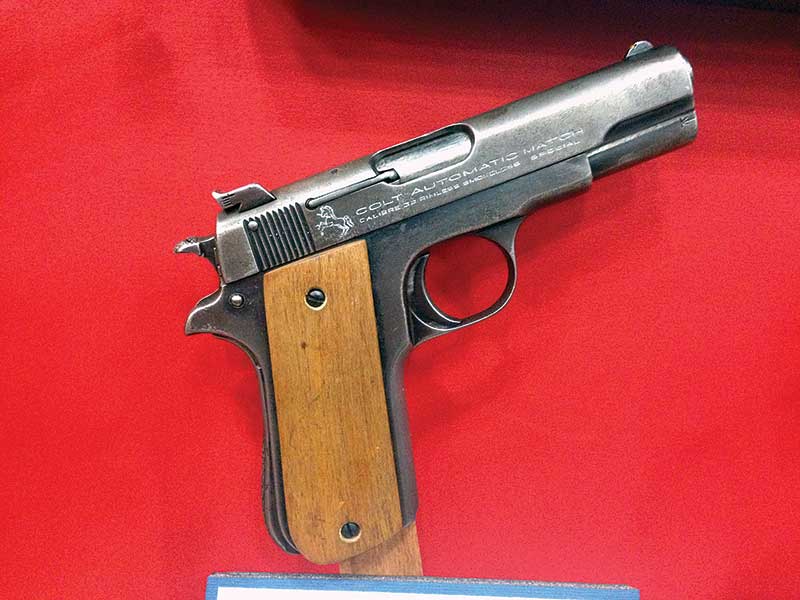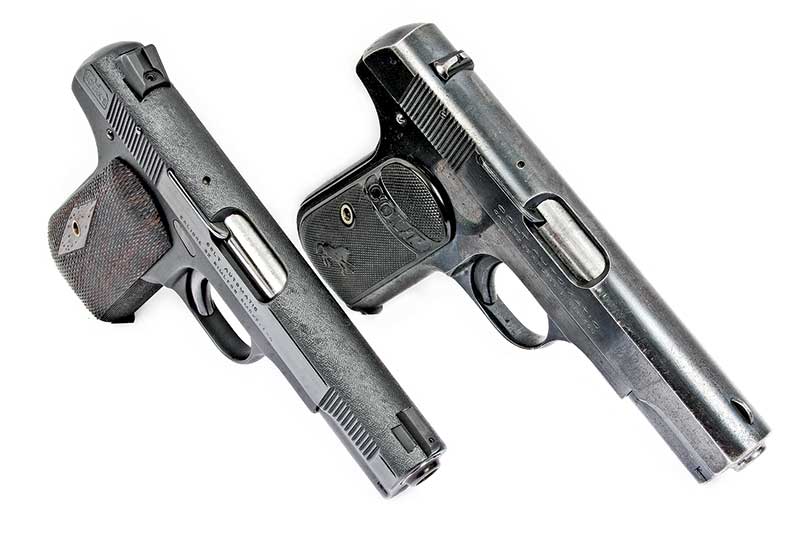Colt’s 1903 Hammerless
‘If I Had A Hammer ...’ Oh Wait — It Does
Lest I be accused of over-using “genius” — this time I’ll reach for more adjectives. To call John Browning a star of steel, a prodigy of protection or even a marvel with metal is still, nonetheless, inadequate. Nothing short of his real label — genius — does him justice. In the history of firearm design there’s simply nobody else who comes close to his wide-ranging accomplishments and influence. While some did create one spectacular model — think Garand, Luger, etc. — nobody has the extensive palate of successful, mainstream designs Browning brought forth. And the 1903 is but one of them.
Okay … two.
Sublimely elegant, this quintessential pocket pistol effortlessly re-wrote what Americans — and then the world — expected in a personal defensive pistol. If you look at most European autos of the time (those not designed by Browning, of course) you find abrupt shapes (Bergman), odd angles (Webley & Scott) or strange actions (the blow-forward Schwarzlose). When the Colt Automatic Pistol, Pocket Model, Hammerless was introduced in Browning’s own .32 ACP cartridge in, oddly enough, 1903, America and the world took notice. It rapidly rose to the top, at home in the pockets and holsters of tens of thousands (eventually over 775,000) of police officers, bank guards, businessmen, home defenders, good guys of all kinds and no small number of bad guys.
It was one of Bonnie Parker’s favorites, the issue pistol to U.S. General Officers and was deployed by the thousands during WWII by the U.S. government to arm the OSS, agents and freedom fighters in Europe. On the home front it guarded factories, kept police safe and assured thousands of citizens their families slept securely. Even today, this classy auto rests in desk drawers and pants pockets still doing its job. But why is this so in this age of polymer and stamped-out sameness?
Occam’s Razor
William of Ockham, a 13th century philosopher and logician, has grown famous over the centuries for his belief: “Plurality must never be posited without necessity.” Essentially, don’t add “stuff” if you don’t need it, whether it be in philosophy — or gun designs. This famous view has morphed over the years and is now spelled as “Occam’s Razor.” The “razor” portion represents the “… shaving off of unnecessary assumptions or unnecessary attributes, facts or theories.” And I think, amazingly enough, this 800-year-old principle is exactly why the 1903 (and later 1908 in .380 ACP) was popular almost 120 years ago and remains so today. There is, simply put, everything you need in a pocket auto — and nothing extra.
The sights are sufficient for their role, the gun has thumb and grip safeties, there is a secure magazine release at the butt, the gun’s operation is simple and rugged and the calibers are at least adequate for their role. Over the decades of production, there have been only a small handful of changes, proving as to the soundness of Browning’s original design. The 1903 went from an external bushing to a bushing-less design, the slide length morphed from 4″ for the 1903 to 3.75″ when the .380 was introduced, and the grip, and later, magazine safeties, were added. There actually wasn’t really a “1908” model or even a “1903” model but both names came into common usage. The 1908 label is simply when the .380 version was introduced.
Interestingly enough, the .32 sold nearly three times as many as the .380 version. Some wonder if it’s because the .32 magazine holds eight while the .380 “only” holds seven. I think it’s because the .32 is so delightful to shoot! While the .380 is arguably more effective, especially with today’s ammo, it is a bit snappier to shoot. Most who bought the autos were not accomplished shooters and stopping power was something few worried about. So, I’m guessing lighter recoil and capacity won out to the tune of three times as many sales. Total production numbers were in the 775,000 range, give or take, with production ceasing in 1945.
Some Mechanics
While the guns look as if there’s no hammer, in reality there’s one lurking just under the nicely curved back end of the slide. The thumb safety “locks” the trigger from moving and if your gun has a grip safety, it too blocks the trigger from moving. It’s a straight blow-back action but being all-steel and weighing in at about 24 oz., it’s also beefy enough to take a recoil beating. Take down is easy and you simply align a scribed mark on the recoil spring dust cover with the front of the frame, rotate the barrel then slide the slide forward off the frame. The barrel comes out easily, along with the recoil spring and presto — the innards present themselves for cleaning. That Browning was a clever fellow.
I count my blessings because I own three. Two 1903 models (made in 1919 and 1917) and one 1908, vintage 1920. I’m doubly blessed though because one of the .32s has been highly customized by Wayne Novak and presents with tiny Novak sights, an extended thumb safety, forward slide serrations, stippling and — be still my thumping heart — has been converted to a 1911-style magazine release button. I know … I know … even the term “amazing” doesn’t do it justice.
I shoot all of mine regularly, and 3.5″ at 15 yards off-hand is quite possible. And, much to my never-ending delight, my 80-yard torso-sized gong makes tiny little “tink” noises when the various .32s and .380s bounce off of it. Great fun? Silly to even ask.
While strolling the NRA show some years ago, I stumbled onto a 1903/08 collector. We had a good visit but then I spotted what looked like a tiny 1911 on his wall. Closer inspection revealed it was a 1903 a back-room gunsmith had modified at some point, cutting off the rear of the slide, exposing the hammer, then brazing on a hammer spur. He capped it off by installing adjustable rear sights. Check out the picture and tell me if it doesn’t look like a certain “other” auto Browning designed later.

